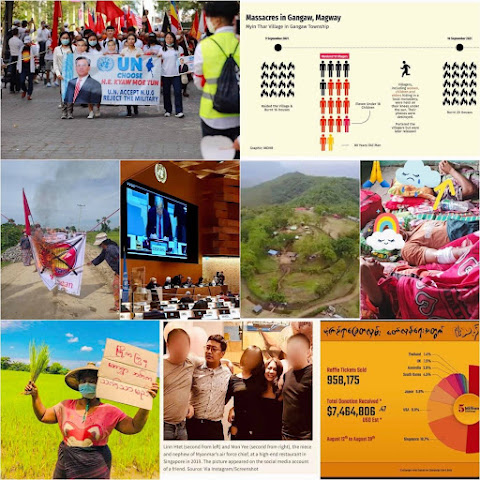26th March, 2021 #day54
As state-sponsored violence continues, retaliations against police and soldiers also escalate across the country. In Monywa, two bodies of policemen were found handcuffed near the town cemetery, the BBC reported. The junta has arrested about 30 people living near the cemetery, but some have been released this evening after paying between 500,000 to 500,000 kyat ($ 350 – 3500), according to the Irrawaddy. Myanmar Now reports that 14 police and soldiers have been confirmed killed across the country since the coup and there are more 15 unconfirmed cases. In Dawei, two plainclothes soldiers were beaten to death after crashing into residents doing night guards in their neighbourhood with their motorcycle. In Kyaukpadaung, one soldier and a son of a military intelligence officer were shot dead on March 20. During a protest in Aungban, Shan State, five soldiers and a policeman were reportedly killed in the knife attack. The attacker named Ye Thu Aung also died in the spot. Protesters praised him as the hero of Aungban and one the heroes of the Spring Revolution. In Phekon township, four soldiers including two officers were killed last week and the army have arrested about 50 villagers. These incidents clearly indicate that the reaction of the protesters has intensified in many places and there could be more bloodshed on both sides in the near future.
Street protests have again intensified as the junta prepares for a major Tatmadaw Day event tomorrow. Even in downtown Yangon, where protests disappear for weeks, a youth-led surprised march occured today. They were able to disperse the protest in time right before the arrival of soldiers. There were also protests in Dala, on the other side of Yangon. Thousands of people gathered on the streets again in Monywa and Taunggyi despite a lot of bloodshed in previous days. However, Myanmar Now confirms that at least four people were killed and at least 20 were injured in a violent crackdown in Myeik, a coastal town in Myanmar. There is no difference in the form of violent tactics carried out by the soldiers and police compared to other places, but police were seen firing at the protesters while driving ambulances. Fire trucks are also painted into white colour and have been widely used to crackdown protests.
The junta is attempting to gain international recognition. The coup leader, Gen. Min Aung Hlaing met with his long-time ally Russia’s Deputy Defence Minister Alexander Fomin in Naypyidaw. He is among the very few senior foreign government officials who have visited Myanmar since the coup. It is more likely that he will attend the tomorrow event while many foreign countries and ethnic armed groups already refused the invitation. State-run MRTV broadcasted that Min Aung Hlaing was showing him captured handmade equipment including Molotov. In tonight news, the junta warned young people and students not to take part in the protests via the state-run MRTV television, as bullets could hit their heads and backs. Many people see this as a direct threat to people who are planning to organize another nationwide protest called “Tabaung Attack” tomorrow. According to Reuters, more than 300 civilians had been killed as of March 25, and at least 264 of them by gunfire, and 76, a quarter of the total victims, had been shot in the head. Amnesty International claimed that “every points to troop adopting shoot to kill tactics to suppress the protests.” However, the junta responded that the death tolls is only 164 and nine security forces had also been killed by the protesters as of March 23, according to the junta. An eyewitness told the BBC that about 100 people were killed in the March 14 shootings in Hlaing Tharyar Township alone. If that statement were true, there would be more than 400 deaths so far.
Six Norwegian professors have nominated the Civil Disobedience Movement for the Nobel Prize in 2022. In a letter to the selection committee, they stated that the CDM movement in Myanmar is a non-violent anti-coup resistance which is “central in forging a positive agenda for substantive democracy and peace in Myanmar.” They added that their nomination is a recognition of all the people of Myanmar and their struggle for democracy. Although mass mobilization like this does not usually win the Nobel Prize, this nomination can boost the spirit of the people and encourage them to continue to use non-violent means. This nomination comes amidst the growing call for an armed resistance and formation of federal army.



Comments
Post a Comment